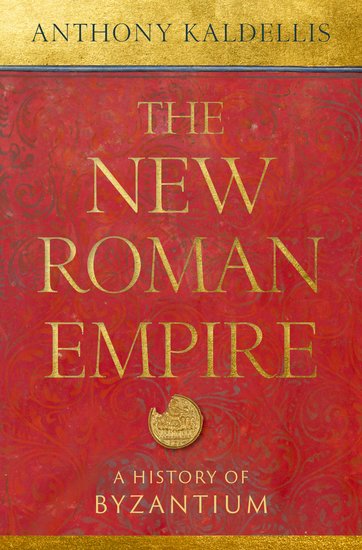The New Roman Empire: A History of Byzantium
- By Anthony Kaldellis
- Oxford University Press
- 1,160 pp.
- Reviewed by Peggy Kurkowski
- December 11, 2023
An epic work of scholarship accessible to lay readers.

For those who like their histories big — with a capital B — this first single-volume chronicle of Byzantium by a sole author in over a generation succeeds on empiric levels. Historian Anthony Kaldellis simply awes in The New Roman Empire, a massive undertaking that captures the large, small, and quotidian events, lives, and oh-so-many intrigues of Byzantium from the age of Constantine to its fall in 1453.
Through a combination of narrative and analysis, Kaldellis examines “one of the most durable states the world has ever seen” and investigates the reasons for the longevity of an empire whose existence spanned a fifth of recorded human history. This fact alone explains the daunting length of the book, which comes in at well over 1,000 pages. But don’t be frightened off: Kaldellis is an engaging writer who ably synthesizes mountains of information for the general reader.
In a tome rife with original insights, the first is stated clearly in the book’s title. Kaldellis eschews the “vacuous names” of “Byzantine” and “Byzantium” (with what he claims are their outdated Western biases around Eastern and “Greek” polities) and instead honors the view of those living in the Eastern Roman Empire that they were indeed the “new Romans” — a continuation of the dying western empire — who colloquially called their home Romanía (i.e., “Romanland”).
Famously founded by the Roman Empire’s first Christian ruler — Constantine the Great — in 330 AD by moving the ancient imperial capital from Rome to Byzantium in the east, New Rome was to continue the Roman tradition, albeit elsewhere. But before Kaldellis begins his sweeping march of emperors, battles, fires, plagues, and the seemingly endless Church councils and schisms, he helpfully examines key concepts around the idea of New Rome and its inhabitants, its government and social order, and the curious relationship between Christianity and Roman order. Here, the author suggests a fresh interpretation of who came out on top in the empire’s early foundation:
“[Christianity] decisively lost to the latter: it was, in fact, co-opted to serve precisely as the Roman religion within the framework of the polity. Specifically, what began as a revolutionary attempt to create a new ‘polity of the Christians’ and new ‘Christian nation’ was tamed so that it became merely ‘the religion of the Romans.’”
Kaldellis pushes back against historiographical “mischaracterizations” of New Rome’s government as a “totalitarian and theocratic-military dictatorship” that suppressed its people and eroded freedom. This “image of oriental despotism” was created during the Enlightenment, he says, and was a fundamental misunderstanding of Roman government. Indeed, one of the foundational elements of the New Roman Empire that helped it survive for more than a millennium was its powerful sense of governmental responsibility and accountability, Kaldellis argues.
Perhaps the most surprising of his unique insights, this focus on “the stewardship of the common good” at the highest levels of political power recurs throughout the narrative. A large pillar of imperial ideology embraced the wellbeing of its subjects as a mark of the empire’s success, despite the occasional overreach. “Emperors were powerful, frustrated, and insecure, but generally principled and dutiful toward the whole of Romanía,” Kaldellis argues, citing that one emperor, Justinian, so took to heart the responsibility to protect the weak that some historians see him as a “proto-Marxist class warrior.”
The level of detail in such an epic catalog of people, places, and events is staggering and delightful by turns. As one reads about the fire that swept through Constantinople in 476 AD, Kaldellis shares the eclectic fact that among the tens of thousands of books burned in the Basilica library was “a complete Homer written in gold letters on the intestine of a serpent.” Strange how the real-life past can read like something out of The Lord of the Rings.
The history of an empire that began when “most of its subjects still worshipped Zeus” and gasped its last breath on the edge of modernity in 1453 deserves patience in its telling, Kaldellis reminds readers. It requires, too, patience in the reading; this is not a book to fly through. But it is one to savor in large or small doses. Including 160 pages of notes, a 16-page bibliography, and a handy glossary of terms that defines the nomenclature over centuries, Kaldellis’ portrait is comprehensive, erudite, and gracefully written. It is also the benchmark for future studies of the New Roman Empire.
Peggy Kurkowski is a professional copywriter for a higher-education IT nonprofit association by day and major history nerd at night. She writes for multiple book review publications, including Publishers Weekly, Library Journal, BookBrowse Review, Historical Novels Review, Open Letters Review, Shelf Awareness, and the Independent. She hosts her own YouTube channel, “The History Shelf,” where she features and reviews history books (new and old), as well as a variety of fiction. She lives in Colorado with her partner (quite possibly the funniest Irish woman alive) and four adorable, ridiculous dogs.

